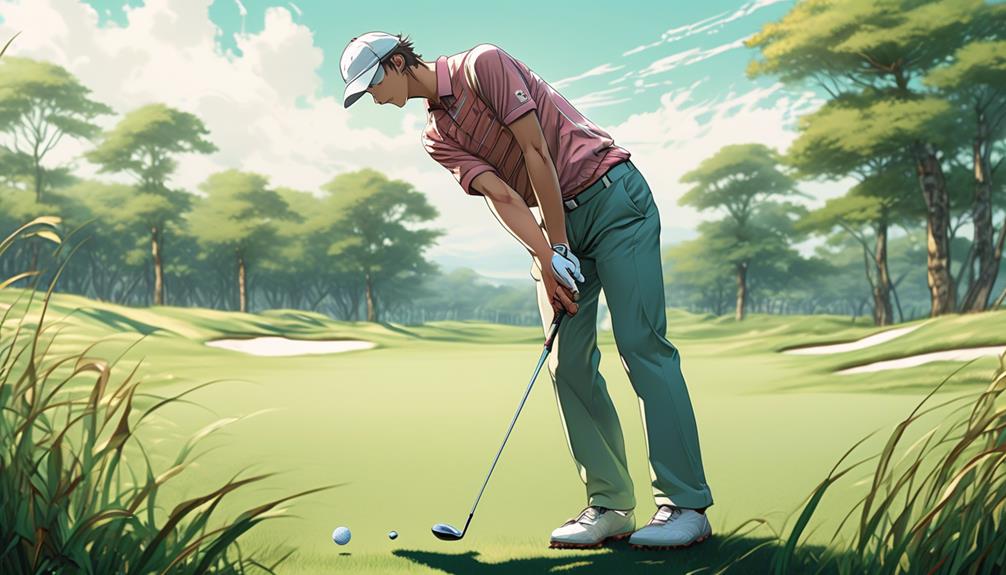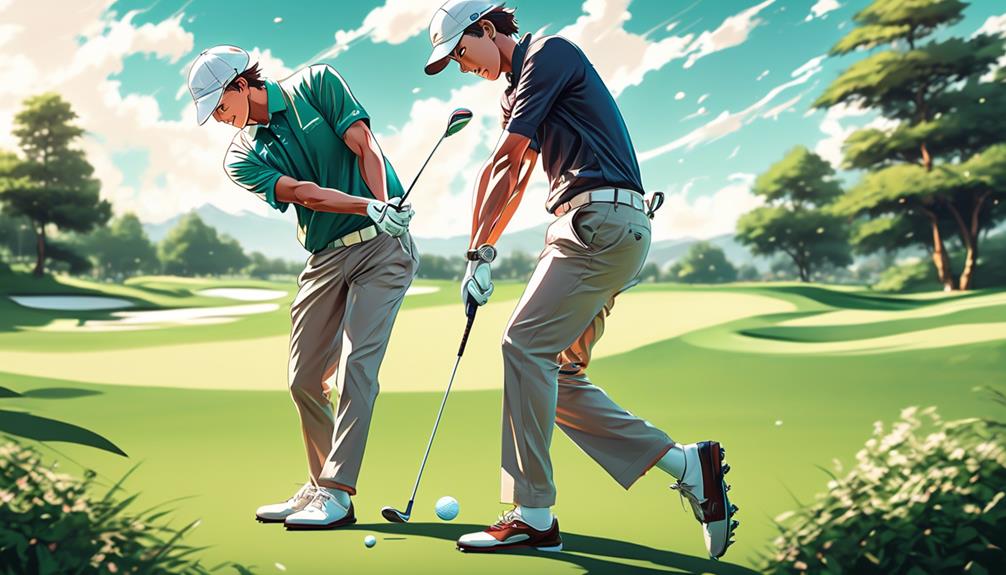

Imagine standing on the lush green fairway, the sun warming your skin as a gentle breeze rustles through the trees. You grip the club firmly, ready to take on the challenge ahead.
Mastering the perfect golf swing is no easy feat, but fortunately, you have the opportunity to learn from a legend. In this discussion, we will explore thirteen invaluable tips from a seasoned pro that will transform your game.
So, if you’re ready to elevate your golfing skills and unlock the secrets of a truly flawless swing, prepare to delve into the wisdom of a true master.
Key Takeaways
- Jack’s strong work ethic and understanding of the game contributed to his success in golf.
- Consistent tempo and power transfer are crucial components of Jack’s swing technique.
- Maintaining a firm wrist position and proper grip are important for consistent ball striking.
- Proper alignment, hand placement, and stance width are key components for success in the golf swing.
The Early Years: Jack’s Golf Beginnings


In the early years, Jack Nicklaus embarked on his journey into the world of golf, laying the foundation for an extraordinary career. Jack’s early influences played a crucial role in shaping his passion for the sport. His father, Charlie, was a skilled golfer and introduced Jack to the game at a young age. Under his father’s guidance, Jack developed a strong work ethic and a deep understanding of the game’s intricacies. This early exposure to golf instilled in Jack a drive for excellence that would propel him to greatness.
As Jack grew older, his golf achievements began to pile up. In high school, he won the Ohio State High School Championship for two consecutive years. This success caught the attention of college recruiters, and Jack went on to play for the Ohio State University golf team. During his time there, he won the U.S. Amateur Championship twice, in 1959 and 1961. These victories solidified his reputation as a rising star in the golfing world.
Jack’s early influences and golf achievements laid the groundwork for the remarkable career that would follow. He’d go on to win a record 18 major championships and cement his status as one of the greatest golfers of all time.
Understanding Jack’s Swing Technique


To understand Jack’s swing technique, you need to focus on his mechanics and the key components that contribute to his success.
Jack’s swing is known for its precision and power, combining a smooth tempo with explosive clubhead speed.
The key components include proper grip, posture, alignment, and a consistent swing plane.
Jack’s Swing Mechanics
Understanding Jack’s swing technique is essential for improving your golf game. Jack Nicklaus, a legendary golfer, had a swing that was known for its impeccable mechanics. Here are some key aspects of Jack’s swing that you can incorporate into your own game:
- Consistent Tempo: Jack had a smooth and steady swing tempo, allowing him to maintain control and precision. Focus on finding your own rhythm and maintaining it throughout your swing.
- Efficient Power Transfer: Jack generated immense power in his swing by utilizing his lower body and transferring it smoothly to his upper body. Work on engaging your legs and hips to generate more power in your swing.
- Balanced Finish: Jack’s swing always ended with a balanced and controlled follow-through. Practice finishing your swing with a stable posture to ensure better accuracy and control.
- Proper Wrist Hinge: Jack had a strong wrist hinge, which contributed to his consistent ball striking. Work on maintaining a firm wrist position throughout your swing to improve your overall ball contact.
Key Components for Success
Mastering the key components of Jack Nicklaus’s swing technique is crucial for achieving success in your golf game.
Two key components that you must focus on are the proper grip and swing tempo.
Firstly, having a proper grip is essential for a consistent and powerful swing. Make sure to position your hands correctly on the club, with your left hand (for right-handed golfers) slightly turned to the right and your right hand directly on top of your left hand. This grip allows for better control and accuracy during your swing.
Secondly, maintaining a smooth and balanced swing tempo is crucial. Jack Nicklaus was known for his rhythmic and effortless swing, which allowed him to generate power and accuracy. Pay attention to the tempo of your swing, ensuring a smooth transition from backswing to downswing.
Grip and Stance: Key Fundamentals


Having a proper grip and stance is crucial for a successful golf swing. Mastering these key fundamentals will greatly improve your game.
Here are four essential tips to help you achieve the correct grip and proper alignment:
- Grip pressure: Hold the club with a firm, yet relaxed grip. Avoid gripping too tightly, as this can restrict your swing and cause tension in your hands and arms.
- Hand placement: Position your hands so that the V between your thumb and index finger points towards your right shoulder (for right-handed players). This neutral grip promotes a square clubface at impact.
- Stance width: Stand with your feet shoulder-width apart, aligning them parallel to the target line. This balanced stance provides a solid foundation for your swing and allows for proper weight transfer.
- Alignment: Aim your clubface and body parallel to the target line. Check that your feet, hips, and shoulders are all pointing in the same direction. This ensures that you’re properly aligned to your target.
Achieving Proper Body Alignment


To achieve proper body alignment in your golf swing, it’s essential to focus on three key points.
First, ensure correct posture and stance by standing tall with a slight bend in your knees and a straight back.
Second, align your hips and shoulders parallel to the target line, creating a neutral spine position.
Lastly, position your feet shoulder-width apart, with the toes slightly flared out.
Correct Posture and Stance
Achieving proper body alignment in your golf swing starts with maintaining correct posture and stance. Here are four essential tips to help you achieve the correct alignment and proper weight distribution:
- Stand with your feet shoulder-width apart and parallel to the target line. This will provide a stable base for your swing.
- Bend your knees slightly and tilt your hips forward. This will help maintain a neutral spine angle and promote better rotation during the swing.
- Keep your upper body relaxed and your shoulders square to the target. Avoid slouching or hunching over the ball, as it can restrict your movement and affect your swing.
- Distribute your weight evenly between your feet. This will ensure balance and stability throughout the swing, allowing you to generate more power and accuracy.
Aligning Hips and Shoulders
Positioning your hips and shoulders correctly is crucial for achieving proper body alignment in your golf swing. Correcting alignment issues and improving body posture can greatly impact the efficiency and accuracy of your swing.
When addressing the ball, ensure that your hips and shoulders are parallel to the target line. Misalignment can lead to inconsistent shots and decreased power. To align your hips, rotate them towards the target while maintaining a stable lower body.
Your shoulders should also rotate in alignment with your hips, ensuring that they’re square to the target. This alignment promotes a more natural and fluid swing, allowing for maximum power and control.
Practice proper body alignment to improve your overall swing mechanics and enhance your performance on the golf course.
Positioning the Feet
Ensure your feet are properly positioned to achieve optimal body alignment in your golf swing. Correct footwork is crucial for maintaining balance and weight distribution throughout your swing. Here are four key tips to help you position your feet correctly:
- Align your feet parallel to the target line: Position your feet so they’re pointing in the same direction as your target line. This helps ensure that your body is aligned properly to the target.
- Maintain proper distance between your feet: The width of your stance should be shoulder-width apart. This provides a stable base and allows for proper weight transfer during your swing.
- Distribute your weight evenly: Make sure your weight is evenly distributed between your feet. Avoid leaning too far forward or backward, as this can negatively affect your balance and swing.
- Use your natural foot alignment: Everyone’s feet have a natural alignment, so use the position that feels most comfortable for you. This will help you maintain stability and generate power in your swing.
The Importance of Tempo and Rhythm


To improve your golf swing, maintaining a consistent tempo and rhythm is crucial. Tempo control refers to the speed at which you swing the club, while rhythm consistency refers to the smoothness and flow of your swing. Both of these elements are essential for achieving accuracy and power in your shots.
When it comes to tempo control, it’s important to find a pace that suits your natural rhythm. Trying to swing too fast or too slow can throw off your timing and lead to inconsistent results. Experiment with different tempos and find the one that allows you to maintain control and generate power in your swing.
Rhythm consistency is equally important. A smooth and rhythmic swing helps create a fluid motion, which translates into better ball striking. One way to achieve rhythm consistency is by focusing on the transition between your backswing and downswing. Smoothly transitioning from one phase to the other without any sudden jerks or pauses can greatly improve your swing.
To develop a consistent tempo and rhythm, practice is key. Spend time on the driving range, focusing on maintaining a smooth and controlled swing. Incorporate drills and exercises that help you develop a consistent tempo and rhythm.
With practice and dedication, you can master the art of tempo and rhythm, resulting in a more consistent and powerful golf swing.
Generating Power With the Lower Body


To generate power in your golf swing, you need to focus on utilizing your lower body effectively.
Hip rotation plays a crucial role in generating power, as it allows you to unleash the energy stored in your core muscles.
Additionally, mastering the weight transfer technique and maintaining lower body stability throughout the swing will ensure maximum power transfer to the clubhead.
Hip Rotation for Power
Maximize the power in your golf swing by harnessing the rotational force generated from your hips. To generate maximum rotational power, focus on improving your hip mobility and incorporating proper hip rotation into your swing technique.
Here are four key tips to help you leverage your hip rotation for power:
- Strengthen your hip muscles: Engage in exercises that target your hip muscles, such as squats, lunges, and hip rotations. Stronger hip muscles allow for better stability and power generation.
- Maintain proper hip alignment: Keep your hips square to the target at address and throughout your swing. This alignment allows for a more efficient transfer of power from your lower body to the clubhead.
- Initiate the downswing with your hips: Start your downswing by rotating your hips towards the target. This movement generates the momentum needed for a powerful swing.
- Use your hips to drive through impact: As you approach impact, focus on driving your hips towards the target. This action helps transfer the rotational power from your hips to the clubhead, resulting in increased swing speed and distance.
Weight Transfer Technique
Improve the power in your golf swing by mastering the weight transfer technique with your lower body. Proper weight distribution is crucial for generating maximum power and distance in your shots.
To execute the weight transfer technique effectively, start by positioning your feet shoulder-width apart and aligning them parallel to your target line. As you initiate your backswing, shift your weight onto your back leg, allowing your hips to rotate naturally.
Then, during the downswing, transfer your weight onto your front foot, driving your hips forward and generating power through the rotation of your lower body. This transfer of weight from back to front allows you to maintain balance and generate the maximum force needed for a powerful swing.
Practice this technique consistently to improve your golf swing and enhance your overall performance on the course.
Lower Body Stability
Mastering the technique of generating power with your lower body involves maintaining stability and utilizing efficient movements. To improve stability and generate maximum power in your golf swing, focus on the following:
- Strengthen your core: A strong core provides a solid foundation for your swing, allowing you to transfer energy effectively from your lower body to the club.
- Engage your glutes: Activate your glute muscles to stabilize your hips and create a powerful rotation during the swing.
- Maintain balance: Practice exercises that challenge your balance, such as single-leg squats or standing on a wobble board. This will help you develop stability in your lower body.
- Utilize proper weight transfer: Shift your weight smoothly from your back foot to your front foot during the swing, transferring energy and generating power.
Mastering the Backswing Sequence


To optimize your golf swing, it’s essential to understand and perfect the sequence of your backswing. The backswing sets the foundation for the entire swing, and analyzing its sequence can help identify common mistakes that may hinder your performance.
When analyzing the backswing sequence, experts focus on the three key components: the takeaway, the shoulder turn, and the wrist hinge.
The takeaway refers to the initial movement of the club away from the ball, and it should be smooth and controlled. Many golfers make the mistake of jerking the club back, leading to inconsistencies in their swing.
The next crucial aspect is the shoulder turn. A proper shoulder turn allows for greater power and control in the swing. Golfers often struggle with this element, failing to rotate their shoulders fully, resulting in a loss of distance and accuracy.
Lastly, the wrist hinge plays a significant role in generating power and clubhead speed. It involves cocking the wrists during the backswing, allowing for a more explosive release of energy during the downswing. Neglecting this crucial movement can lead to a lack of power and distance.
The Crucial Downswing Mechanics


Understanding the mechanics of the downswing is essential for achieving a powerful and accurate golf swing. The downswing is the moment when you transition from the backswing to striking the ball. Here are four crucial aspects of the downswing that you need to master:
- Maintain proper timing: The timing of your downswing is crucial for generating maximum power and accuracy. Start the downswing by shifting your weight from your back foot to your front foot and then rotate your hips and shoulders simultaneously. This sequence of movements will help you transfer energy efficiently and create a powerful strike.
- Initiate the clubhead drop: As you start the downswing, allow the clubhead to drop naturally by releasing the tension in your wrists. This drop in the clubhead will enable you to achieve a proper clubface position at impact.
- Maintain a smooth transition: Smoothness and rhythm are key elements of a successful downswing. Avoid any abrupt or jerky movements that can disrupt the flow of your swing. Practice maintaining a seamless transition to ensure consistency and accuracy.
- Rotate your body: Engage your core muscles and rotate your body through the downswing. This rotational movement will help generate power and maintain control over the clubface position.
Impact Position: Striking the Ball Purely


Achieving a pure strike when striking the ball in golf requires precise positioning and timing at impact. To achieve this, you need to focus on your striking technique and ball contact. The key is to make sure that the clubface contacts the ball square and center, without any glancing blows. This ensures maximum distance and accuracy.
To achieve the perfect impact position, start by aligning your body and clubface correctly. Your hips, shoulders, and clubface should be parallel to the target line. As you swing, maintain a slight forward press with your hands ahead of the clubhead at impact. This helps ensure a downward strike on the ball and prevents scooping.
Timing is crucial in achieving a pure strike. You want your hands to be in front of the ball at impact, while your weight is shifting onto your front foot. This creates a descending blow and maximizes the compression of the ball.
Maintaining Balance Throughout the Swing


Maintaining balance throughout your golf swing is crucial for consistent and powerful ball striking. It not only helps you stay in control of your body movements but also improves swing speed. Here are four tips to help you maintain balance and improve your swing speed:
- Proper setup: Begin by positioning your feet shoulder-width apart and distributing your weight evenly on both feet. This will create a stable foundation for your swing.
- Engage your core: Your core muscles play a significant role in maintaining balance. Strengthen them through exercises like planks and rotational movements to enhance stability during your swing.
- Maintain a smooth tempo: Rushing your swing can throw off your balance. Focus on maintaining a smooth and consistent tempo throughout your swing, allowing your body to stay in sync and maintain balance.
- Stay grounded: Keep your feet firmly planted on the ground throughout your swing. This will prevent any unnecessary weight shifts or loss of balance, enabling you to generate more power and control.
Fine-Tuning Your Short Game With Jack’s Tips


To fine-tune your short game, take advantage of Jack’s expert tips. Improving chip and pitch shots is crucial for lowering your scores and becoming a well-rounded golfer. Here are some fine-tuning short game techniques from Jack Nicklaus himself.
- Develop a consistent setup: Place the ball slightly back in your stance, lean your weight towards your front foot, and open your stance slightly for better control.
- Master the hinge and hold: Practice a smooth wrist hinge on your backswing and maintain that angle through impact. This technique provides better contact and more control.
- Utilize the bounce: When chipping, use the bounce of your wedge to slide under the ball, creating a clean strike and preventing digging.
- Control your trajectory: Adjust your club selection and swing length to vary your shot height. This skill allows you to tackle various greenside situations.
- Perfect your distance control: Practice hitting pitch shots to specific targets, focusing on landing the ball softly and controlling the roll-out.
Mental Focus and Visualization Techniques


Now that you have fine-tuned your short game with Jack’s expert tips, it’s time to shift your focus to mental focus and visualization techniques that will help elevate your golf game. The way you approach the game mentally can have a significant impact on your performance.
Here are four techniques to help you enhance your mental focus and overcome any mental blocks that may be holding you back:
- Visualizing success: Take a moment before each shot to visualize yourself executing the perfect swing and hitting the ball exactly where you want it to go. Imagine the feeling of the club making contact with the ball and the ball soaring through the air towards your target. This mental imagery can help program your mind for success and build confidence.
- Breathing exercises: Deep breathing can help calm your mind and body, allowing you to stay present and focused. Take a slow, deep breath in through your nose, hold it for a moment, and then exhale slowly through your mouth. Repeat this process a few times before each shot to help center yourself and clear your mind.
- Positive self-talk: Replace negative thoughts and self-doubt with positive affirmations. Remind yourself of past successes and focus on the strengths of your game. Use phrases like ‘I am a confident and skilled golfer’ or ‘I can handle any challenge that comes my way.’ This positive self-talk can help boost your confidence and keep you motivated.
- Letting go of mistakes: It’s important to learn from your mistakes, but dwelling on them can hinder your performance. After a bad shot, take a moment to acknowledge what went wrong, then let it go. Focus on the present moment and the next shot ahead. Dwelling on past mistakes only creates unnecessary mental baggage that can affect your future performance.
Practicing Like a Champion: Jack’s Training Insights


To practice like a champion and gain valuable insights from Jack, incorporate these training techniques into your regimen.
Jack’s training regimen focuses on perfecting the swing technique, ensuring that every shot is executed with precision and consistency. One of his key insights is to start with the basics and build a solid foundation. This means practicing the fundamentals of grip, stance, and posture to ensure a strong and stable swing.
Jack emphasizes the importance of repetition and consistency in training. He recommends dedicating regular practice sessions to specific aspects of the swing, such as the backswing, downswing, and follow-through. By breaking down the swing into individual components and practicing them separately, you can identify and address any weaknesses or areas for improvement.
Jack also stresses the importance of feedback and analysis. Recording your swing and reviewing it with a trained eye can provide valuable insights into your technique and help you make necessary adjustments.
Additionally, he suggests incorporating drills and exercises that simulate on-course situations, such as hitting from different lies or practicing shots under pressure.
Frequently Asked Questions
What Is Jack Nicklaus’ Favorite Golf Course to Play On?
Jack Nicklaus’ favorite golf course to play on is difficult to determine without the context of his course strategy. However, knowing his expertise, he likely approaches each course with precision and a strategic mindset.
How Many Golf Tournaments Did Jack Nicklaus Win in His Career?
In his career, Jack Nicklaus won an impressive number of golf tournaments. His swing technique and career highlights are worth studying to improve your own game.
What Are Some Common Mistakes Beginners Make When Learning the Golf Swing?
When learning the golf swing, beginners often make common mistakes. One of these is neglecting the importance of weight distribution. It’s crucial to distribute your weight properly to achieve a successful swing.
Are There Any Specific Exercises or Stretches That Jack Nicklaus Recommends for Improving Flexibility in the Golf Swing?
To improve flexibility in your golf swing, Jack Nicklaus recommends specific exercises and stretches. These will not only help prevent common swing mistakes but also enhance your overall performance on the course.
How Does Jack Nicklaus Mentally Prepare for a Round of Golf?
To mentally prepare for a round of golf, Jack Nicklaus emphasizes the power of visualization. By picturing each shot in his mind, he sets himself up for success on the course.
Conclusion
Now that you have learned Jack’s 13 tips for mastering the perfect golf swing, it’s time to put them into practice.
With the right grip, stance, and body alignment, along with a focus on tempo, balance, and mental visualization, you can elevate your golf game to new heights.
Remember, practice like a champion and watch as your skills improve. Keep striving for greatness on the golf course and never stop honing your skills.
The journey to becoming a master golfer starts now.







